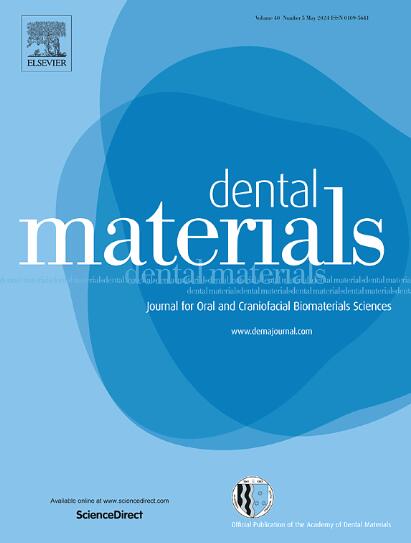Effect of beam divergence on the irradiance from dental light curing units
IF 4.6
1区 医学
Q1 DENTISTRY, ORAL SURGERY & MEDICINE
引用次数: 0
Abstract
Objective
This study measured the beam divergence angle and light output from dental light curing units (LCUs). Twenty LCUs were assessed using a laboratory-grade wide beam imager to determine the relationship between the beam divergence on the irradiance as a function of distance from the light tip.
Methods
The irradiance (mW/cm2) and beam divergence angles (°) at 5, and 10 mm from the tips of 18 Light-Emitting Diode (LEDs), 1 Quartz-Tungsten-Halogen (QTH), and 1 Laser diode LCU.
Results
There were significant differences in the power, irradiance, and emission spectra from the 20 LCUs. At 10 mm from the LCU tip, the irradiance delivered by one LCU decreased by approximately 85.7 %, whereas this decrease was as low as 5.6 % for a different LCU. There was a positive correlation between the divergence angle reported by the wide beam imager and the reduction in irradiance. The laser diode LCU had the least beam divergence and the smallest decrease in irradiance as the distance increased. In contrast, the QTH LCU with the turbo light guide had the greatest beam divergence and the greatest reduction in irradiance as the distance increased. 50 % of the LCUs tested would require exposure times longer than 20 s to deliver 10 J/cm2 at the 10 mm distance.
Significance
The wide beam imager is a useful tool for measuring the beam divergence from LCUs and predicting the effect of distance on their irradiance. At 10 mm, some LCUs may require a fivefold increase in the exposure time to deliver the same energy they deliver at 0 mm from the tip of the LCU.
光束发散对牙科光固化装置辐照度的影响。
目的:研究牙科光固化装置(lcu)的光束发散角和光输出。使用实验室级宽光束成像仪评估了20个lcu,以确定光束发散度与辐照度之间的关系作为与光尖端距离的函数。方法:测量18个发光二极管(led)、1个石英钨卤(QTH)和1个激光二极管LCU在距离尖端5、10 mm处的辐照度(mW/cm2)和光束发散角(°)。结果:20种lcu的发光功率、辐照度和发射光谱均有显著性差异。在距离LCU尖端10 mm处,一个LCU的辐照度下降了约85.7% %,而另一个LCU的辐照度下降了5.6% %。宽光束成像仪报告的发散角与辐照度降低之间存在正相关关系。随着距离的增加,激光二极管LCU的光束发散最小,辐照度下降最小。相比之下,带涡轮导光的QTH LCU随着距离的增加,光束发散最大,辐照度降低最大。50% %测试的lcu需要超过20 秒的曝光时间才能在10 mm距离上提供10 J/cm2。意义:宽光束成像仪是测量lcu光束发散度和预测距离对其辐照度影响的有用工具。在10 mm处,一些LCU可能需要增加5倍的曝光时间,以提供与LCU尖端0 mm处相同的能量。
本文章由计算机程序翻译,如有差异,请以英文原文为准。
求助全文
约1分钟内获得全文
求助全文
来源期刊

Dental Materials
工程技术-材料科学:生物材料
CiteScore
9.80
自引率
10.00%
发文量
290
审稿时长
67 days
期刊介绍:
Dental Materials publishes original research, review articles, and short communications.
Academy of Dental Materials members click here to register for free access to Dental Materials online.
The principal aim of Dental Materials is to promote rapid communication of scientific information between academia, industry, and the dental practitioner. Original Manuscripts on clinical and laboratory research of basic and applied character which focus on the properties or performance of dental materials or the reaction of host tissues to materials are given priority publication. Other acceptable topics include application technology in clinical dentistry and dental laboratory technology.
Comprehensive reviews and editorial commentaries on pertinent subjects will be considered.
 求助内容:
求助内容: 应助结果提醒方式:
应助结果提醒方式:


